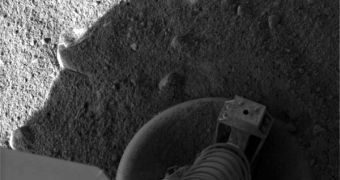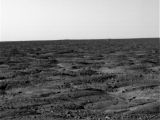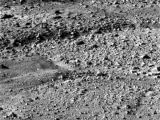On Sunday 16:53 PDT, NASA's Phoenix Mars Lander assisted by a series of spacecrafts in the orbit of the Red Planet successfully touched down on the surface and has since transmitted a series of pictures of the north polar plains, which it will be investigating in the months to come. Initial measurements show that the spacecraft it tilted at only 0.25 degrees from the horizontal, meaning that it has cleared all the boulders in the surrounding area and is in no danger of topping over or of not getting enough sunlight in the harsh Martian arctic atmosphere.
Approximately 15 minutes after the landing has been confirmed, Phoenix unfolded its solar panels - the short delay being necessary to allow the surrounding dust to clear - and started feeding power into its batteries. Without the solar panels Phoenix would only last for 34 hours before running out of power. The second time it passed over the designated spot where Phoenix landed, the Mars Odyssey spacecraft orbiting the Red Planet confirmed that the solar panels had been deployed, along with a series of other scheduled sequences that had to be completed in the first 90 minutes after touchdown.
As opposed to the other landing spots chosen for previous missions, this particular one is relatively clear of any high densities of rocks, not because rocks do not present scientific interest, but due to the fact that they could have endangered the safe landing of the spacecraft. "Just looking at the rocks will tell us something about the history of this site", said principal investigator Peter Smith.
The area where Phoenix landed presents polygonal patterns on the surface, each about 5 meters across, and were probably created by subsurface ice during successive expansion and contraction events, suggesting that ice material lies just below the spacecraft and within the reach of its robotic arm. A three-dimensional model of the landing spot should be available in about two or three days, says principal investigator Peter Smith.
This model will be critical for the operation of the robotic arm, which will be digging in the soil below to collect samples and study them, search for organic molecules and establish whether or not Mars was once somehow more hospitable for life than it is today.
The first images returned by Phoenix show that the solar panel has been successfully deployed and contain some of the first surface pictures of the northern regions of the planet and its weird-looking patterned landscape. One of the pictures (second image) shows the horizon line of the area where Phoenix landed along with a white object, probably the protective shell of the lander, although it hasn't been confirmed yet.
Other images show the patterned surface of the planet, similar to the polygons observed by the orbiters around Mars. Images started arriving to Earth at 19:00 PDT and were relayed through the Mars Odyssey orbiter passing over the landing site of the Phoenix spacecraft.
Additional data relayed during descent shows that Phoenix executed a 'pirouette' maneuver as it entered the Martian atmosphere, exactly as NASA had planned. "We rehearsed all of the problems, and none of them occurred", Phoenix project manager Barry Goldstein said.
Almost none, because the parachute of the spacecraft allegedly opened 7 seconds later than expected, preventing Phoenix from landing exactly in the center of the landing ellipse. This is the first time since 1976, when Viking I touched town on the surface of Mars, that NASA carries out a landing with the help of a pulse landing system. Previous missions were conducted with the help of inflatable air bags, including the Mars Pathfinder and the Mars Exploration Rover - Spirit and Opportunity - missions to the Red Planet.
The next scheduled mission to Mars is the Mars Science Laboratory, which will also land through a thruster system but will be carrying a significantly heavier payload than Phoenix did. Manned missions to the Red Planet will also see the use of the pulse landing system. "The way we're going to land humans on Mars is with propulsive systems and landing legs", said Ed Weiler, associate administrator of NASA's Science Mission Directorate.
More information regarding the health status of the Phoenix Mars Lander will be made available by NASA later today.

 14 DAY TRIAL //
14 DAY TRIAL // 

